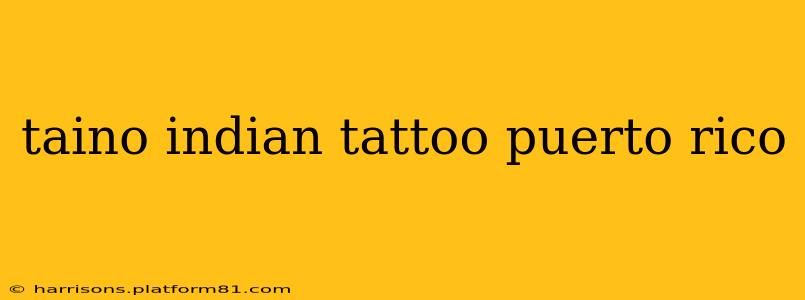The indigenous Taíno people of Puerto Rico left behind a rich legacy, and a significant part of that heritage is expressed through their intricate and symbolic tattoos. These weren't mere decorations; they were powerful representations of spirituality, social status, and individual identity. Understanding Taino tattoos provides a window into their complex culture and offers a fascinating glimpse into the past.
While physical examples of Taíno tattoos are scarce due to the perishable nature of skin and the historical impact of colonization, we can reconstruct a fairly comprehensive understanding thanks to surviving accounts from early Spanish chroniclers and archaeological findings. This article delves deep into the world of Taíno tattoos, exploring their meaning, designs, and significance within their society.
What did Taino tattoos symbolize?
Taino tattoos held profound meaning, often reflecting a person's social standing, achievements, and spiritual beliefs. They were not applied randomly but followed specific patterns and styles dictated by tradition and ritual.
-
Social Status: Certain tattoo designs might indicate a person's role within the community, whether they were a chief, shaman, or skilled artisan. The complexity and placement of the tattoos often correlated with social hierarchy. More elaborate designs, for instance, could signify higher rank.
-
Spiritual Beliefs: Many designs incorporated representations of deities, spirits, and natural elements central to Taíno spirituality. These tattoos served as visible connections to the spirit world and acted as a form of protection or a conduit for communicating with ancestral forces. The zemi, powerful spirits inhabiting the natural world, were frequently depicted.
-
Personal Identity: While social status played a role, individual tattoos could also represent personal experiences, achievements, or aspirations. A successful hunt or a significant life event could be commemorated through a new addition to an existing tattoo or a completely new design.
What were common Taino tattoo designs?
While precise reconstruction of every design is impossible, recurring motifs appear in historical accounts and surviving artifacts. Common symbols included:
-
Zemi figures: Depictions of these powerful spirits, often anthropomorphic or zoomorphic, were prominent. Their forms varied depending on the specific zemí being represented.
-
Geometric patterns: Lines, spirals, circles, and other geometric shapes were frequently incorporated, often symbolizing natural elements or cosmological concepts.
-
Animal representations: Images of animals significant to Taíno culture, such as iguanas, birds, and fish, also featured prominently. These animals held symbolic meaning reflecting beliefs about power, fertility, or transformation.
-
Human figures: Stylized human figures, possibly representing ancestors or important figures in Taíno mythology, also appeared in some tattoos.
How were Taino tattoos applied?
The Taíno used a process of puncturing the skin and inserting pigment. The exact method remains unclear, but historical accounts suggest the use of thorns, sharp fish bones, or other pointed instruments to create the punctures. The pigment was likely derived from natural sources, such as charcoal, crushed minerals, or plant-based dyes. The process would have been a ritualistic and communal event, involving elders and shamans.
What materials were used in Taino tattoos?
Evidence suggests the Taíno primarily utilized natural pigments for their tattoos. These likely included:
-
Charcoal: Created by burning wood, it would have offered a dark, readily available pigment.
-
Plant-based dyes: Various plants indigenous to Puerto Rico could have been processed to yield different colored pigments. Further research is needed to definitively identify the specific plants used.
-
Mineral pigments: Certain crushed minerals could have provided additional colors, though this remains less certain than the use of charcoal and plant dyes.
Where were Taino tattoos located on the body?
The placement of tattoos varied, potentially relating to their symbolic meaning. Some sources suggest tattoos were more concentrated on certain body parts, while others indicate a wider distribution across the body, depending on the individual and the number of tattoos.
Did Taino tattoos have any connection to healing or medicine?
While direct evidence is limited, some researchers suggest a connection between Taíno tattoos and healing practices. The designs might have held symbolic power, assisting in the treatment of illness or injury. It is possible that specific tattoo designs were believed to have healing properties. However, more research is needed to confirm this connection.
In conclusion, Taíno tattoos represent a captivating aspect of their rich culture. While much remains unknown, research continues to shed light on these intricate designs and their significance within the lives of the Taíno people. Studying these tattoos offers invaluable insights into the spiritual beliefs, social structures, and artistic traditions of a fascinating civilization. Further research and archaeological discoveries promise to enrich our understanding of this vital aspect of Puerto Rican history.
